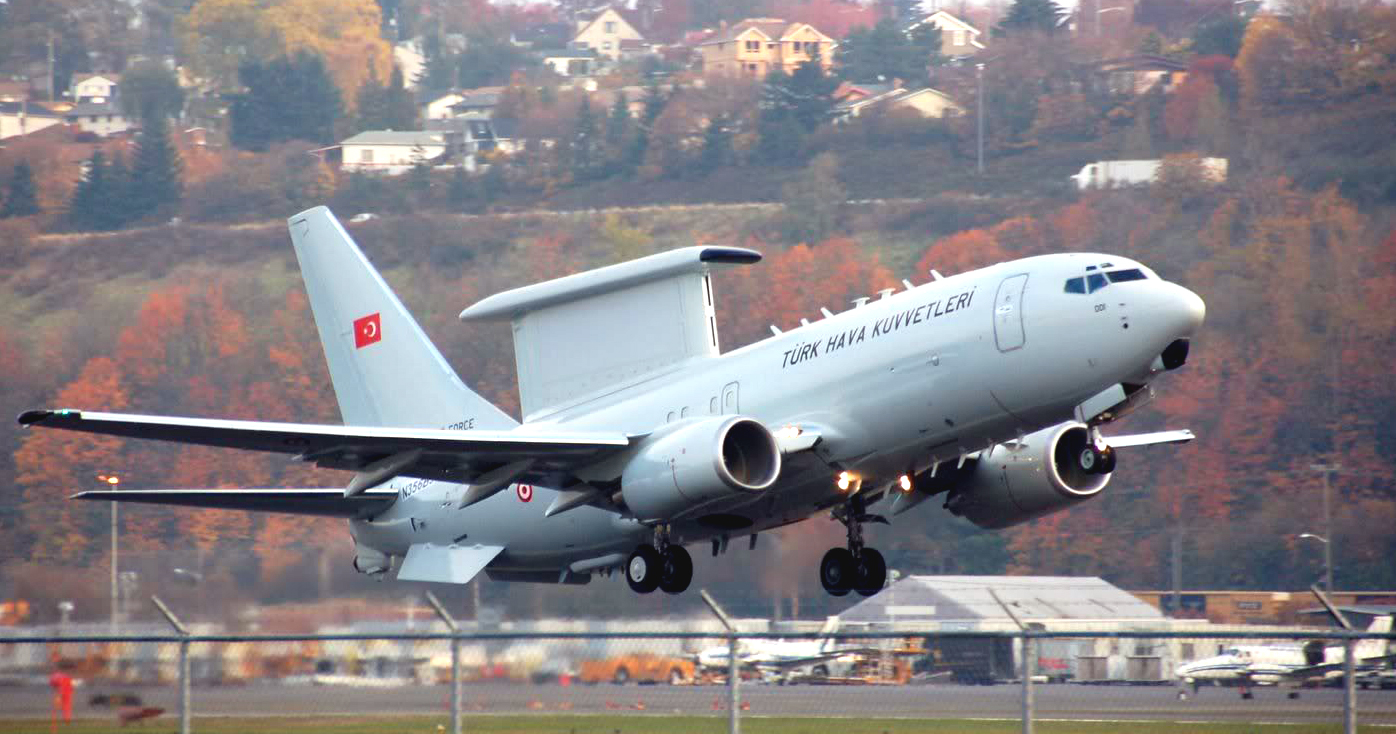You are using an out of date browser. It may not display this or other websites correctly.
You should upgrade or use an alternative browser.
You should upgrade or use an alternative browser.
AWACS, AEW/C & Special Purposes Aircraft
- Thread starter Scorpion
- Start date
Scorpion
THINK TANK: SENIOR
Grumman S-2 Tracker

The Grumman S-2 is only operated by Argentina Air Force
- Origin
- USA
- Type
- carrierborne and land-based anti-submarine warfare aircraft
- Max Speed
- 230 kt / 265 mph
- Max Range
- 2,092 km / 1,300 miles
- Dimensions
- span 22.12 m / 72 ft 7 in
- length 13.26 m / 43 ft 6 in
- height 5.05 m / 16 ft 7 in
- Weight
- empty 8,505 kg / 18,750 lb
- maximum take-off 13,222 kg / 29,150 lb
- Powerplant
- two 1137-kW (1,525-hp) Wright R-1820-82WA Cyclone radial piston engines
- Armament
- one Mk 47 or Mk 101 nuclear depth bomb or similar store in the weapons bay plus a variety of bombs, rockets or torpedoes on six underwing stores stations; search devices include 60 echo-sounding depth charges in fuselage and 32 sonobuoys in engine nacelles
- Operators:
- Argentina, Brazil, South Korea, Peru, Thailand, Turkey, Taiwan, Uruguay
The Grumman S-2 is only operated by Argentina Air Force
Scorpion
THINK TANK: SENIOR
Lockheed Martin AC-130E Spectre
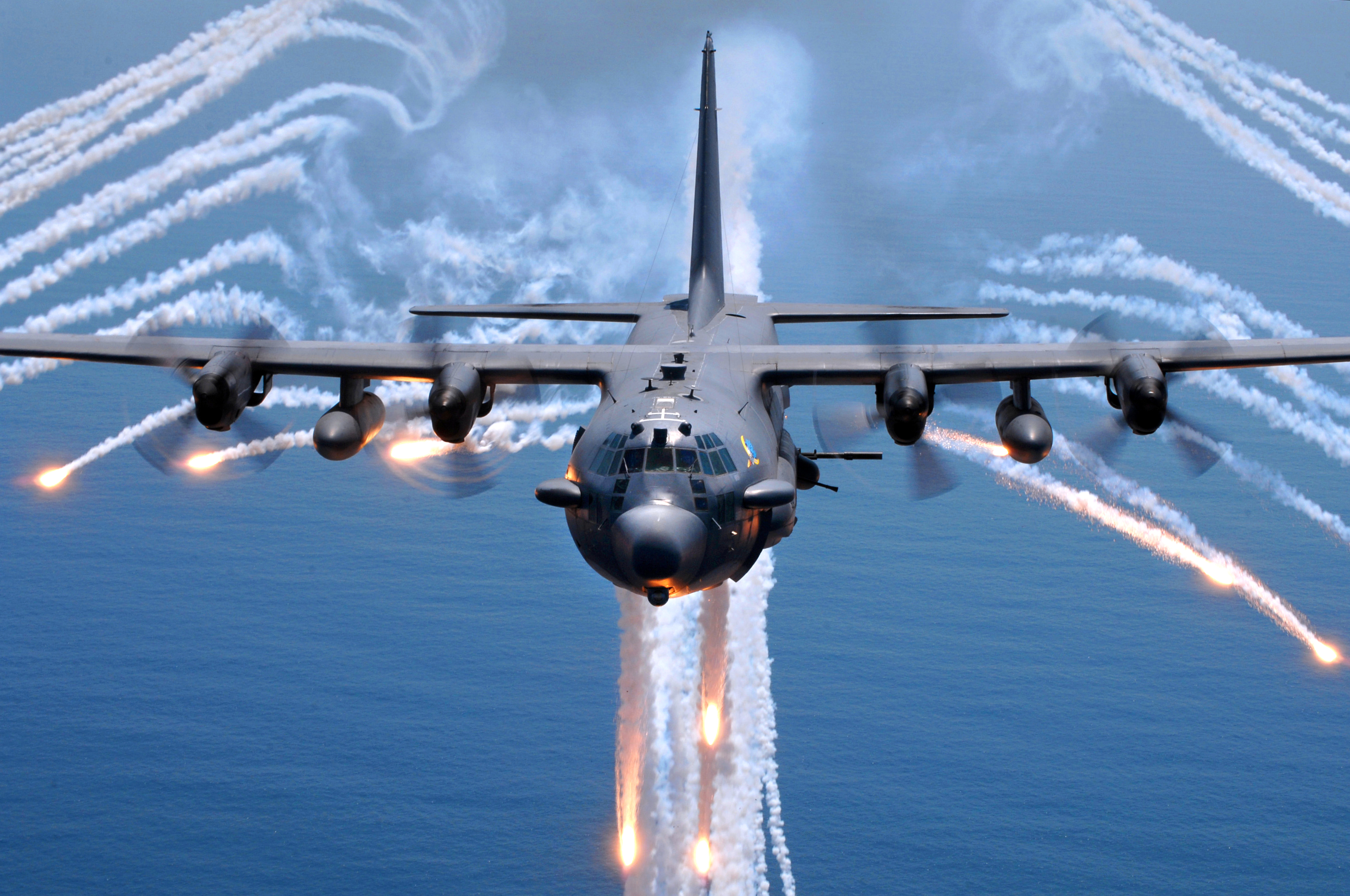

- Origin
- USA
- Type
- multi-sensor ground-attack gunship
- Max Speed
- 612 km/h / 380 mph
- Max Range
- 4667 km / 2,900 miles
- Dimensions
- span 40.41 m / 132 ft 7 in
- length 29.79 m / 97 ft 9 in
- height 11.66 m / 38 ft 3in
- Weight
- empty 33,063 kg / 72,892 lb; max take-off 70,307 kg / 155,000 lb
- Powerplant
- four 3020-ekW (4,050-eshp) Allison T56-A-7 turboprops
- Armament
- one 105-mm (4.13-in) howitzer, two 40-mm Bofors cannons, two 20-mm Vulcan cannons and four 7.62-mm (0.3-in) Miniguns
- Operators:
- United States
Scorpion
THINK TANK: SENIOR
Lockheed Martin P-3 Orion


- Origin
- USA
- Type
- 10-crew anti-submarine warfare and maritime patrol aircraft
- Max Speed
- 411 kt / 473 mph
- Max Range
- 3,835 km / 2,383 miles
- Dimensions
- span 30.38 m / 99 ft 8 in
- length 35.61 m / 116 ft 10 in
- height 10.27 m / 33 ft 8.5 in
- Weight
- empty 27,892 kg / 61,491 lb
- maximum take-off 61,235 kg / 135,000 lb
- Powerplant
- four 3661-ekW (4,910-eshp)Allison T56-A-14turboprops
- Armament
- one 907-kg (2,000-lb) or three 454-kg (1,000-lb) mines, or eight depth bombs, or torpedoes, or combinations of these weapons in the lower-fuselage weapons bay, plus up to 7257 kg (16,000 Ib) of mines, torpedoes, rockets orAGM-84 Harpoon anti-ship missiles on the 10 underwing stations, and 87 sonobuoys launched from tubes in the lower fuselage
- Operators:
- Argentina, Australia, Brazil, Canada, Chile, Greece, Iran, Japan, South Korea, Netherlands, Norway, New Zealand, Pakistan, Portugal, Spain, Thailand, United States
Scorpion
THINK TANK: SENIOR
Lockheed Martin TR-1
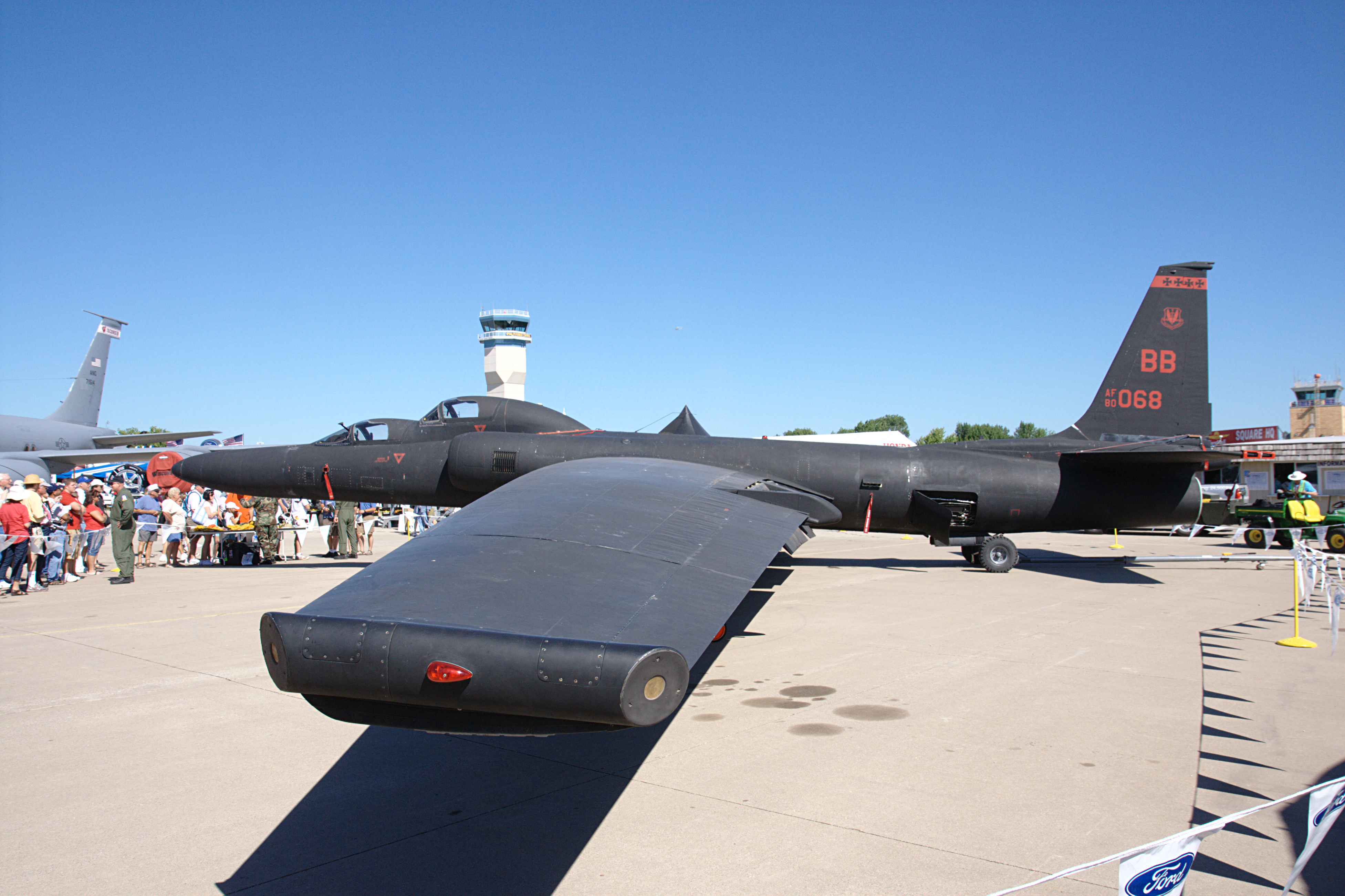

- Origin
- USA
- Type
- single-seat high-altitude reconnaissance aircraft
- Max Speed
- 692 km/h / 430 mph
- Max Range
- 10050 km / 6,250 miles
- Dimensions
- span 31.39 m (103 ft 0 in)
- length 19.13 m (62 ft 9 in)
- height 4.88 m (16 ft 0 in)
- Weight
- empty 7031 kg (15,500 Ib); maximum take-off 18733 kg (41,300 Ib)
- Powerplant
- one 7711-kg (17,000-lb) dry thrust Pratt & Whitney J75-P-13B turbojet
- Armament
- none
- Operators:
- United States (U-2 / TR-1)
Scorpion
THINK TANK: SENIOR
SAAB 2000 ERIEYE AEW&C

Technical Specification
Max endurance > 9.5 hours
Max range > 2,000 NM
Time to climb 25,000 ft* 15 min
Cruise speed 340 knots (TAS)
Patrol speed 160 knots (IAS)
Takeoff distance 1,400 m
Service ceiling 30,000 ft
*Radar operational three mins after takeoff and during climb
Mission assumptions
ISA standard atmosphere, sea level airfield, nil wind
Note: Actual performance depends on specific aircraft configuration.
Radar system performance



Technical Specification
Max endurance > 9.5 hours
Max range > 2,000 NM
Time to climb 25,000 ft* 15 min
Cruise speed 340 knots (TAS)
Patrol speed 160 knots (IAS)
Takeoff distance 1,400 m
Service ceiling 30,000 ft
*Radar operational three mins after takeoff and during climb
Mission assumptions
ISA standard atmosphere, sea level airfield, nil wind
Note: Actual performance depends on specific aircraft configuration.
Radar system performance
- Active phased-array pulse-doppler multi-mode radar
- 450 km range and above 20 km (65,000 ft) altitude coverage
- Effective surveillance area of 500,000 km2
- Combined air and sea surveillance
- Automatic tracking of priority air targets
- Identification friend-or-foe (IFF) system


- External
- SPS
- SATCOM and data links solutions
- ERIEYE radar
- Internal
- Lavatory
- Rest area
- Mission operator console
- Folding seat
- Auxiliary fuel tank
- Electronic Warfare (EW) equipment
- ERIEYE power units
- ERIEYE equipment
- Crew bunks
- Communications rack
- Galley
- Cargo
- Electronic support measures
- 360º azimuth coverage
- High sensitivity
- Wide band
- High accuracy
- Radar warning
- SPS control/management
- Radar Warning Receiver (RWR), chaff and flares
- SPS also features optional Missile ApproachWarning (MAW) and Laser Warning System (LWS)
- Secure communication
- Secure data links
- Secure voice communication
- Mission operator consoles
- Main functions: system and sensormanagement, mission planning and simulation,track data processing, asset management andcontrol, identification and allocation
- Display system: high-resolution flat-panel colourdisplays and touch input display control
- Geographical info: digital map
- Application software: high-level language
The PLA has had a long standing interest in acquiring an AEW&C/AWACS capability. Its earliest experiments involved the indigenous KJ-1 / Project 926 system carried in a rotodome by a turboprop powered Tu-4 Bull, itself a Soviet clone of the B-29 Superfortress (examples have survived in museums).
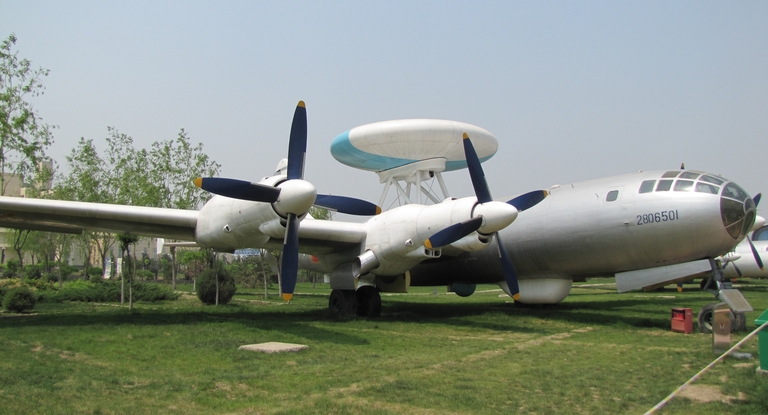
Never regarded to be particularly successful, the KJ-1 was China's first attempt to develop an AEW&C capability, during the 1960s. A surviving example is on display at Datangshan. The conventional rotodome on a rotational coupler employed back to back radar and IFF antennas, emulating the US Navy E-2B/C series ( © 2010, Air Power Australia; via Zhenguan Studio).
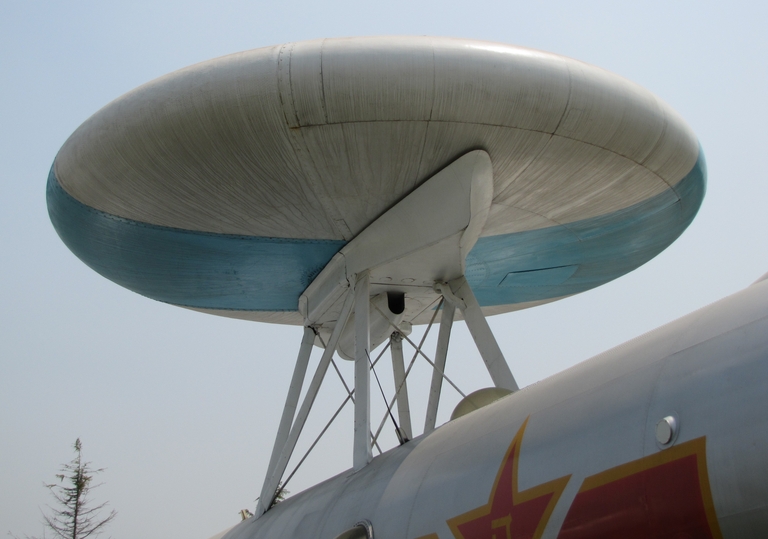
By the 1990s the PLA decided it had to have an AEW&C capability after observing the rout of the Iraqi air force in Desert Storm, and the Serbian air force in Allied Force. China sought to acquire the latest technology and contracted Israeli industry to rehost the Elta Phalcon L-band phased array radar, at the time also bid to the RAAF on an A-310 airframe, on a Russian Ilyushin Il-76 Candid airframe, emulating the Soviet Beriev A-50 Mainstay AEW&C design. The L-band Phalcon was the basis of the Elta bid for the RAAF Wedgetail program and is a generation ahead of Japan's E-767 AEW&C and Taiwan's E-2T Hawkeye.
US pressure on Israel killed the A-50I deal in July, 2000, upon which reports soon emerged that the Russian Beriev A-50U or A-50E variant, equipped with the Schmel series mechanically steered array, was to be purchased. India subsequently signed with Israel to pick up the A-50I instead of China.
The collapse of China's plan to acquire the Beriev A-50I AEW&C with the Israeli Elta Phalcon phased array radar was a significant setback for the PLA-AF, and loss of face globally to the US. The Chinese leadership vowed publicly they would get an AEW&C capability.
Unsupported claims of an impending buy of the Russian Beriev A-50U or A-50E continued, until photographs emerged on the Internet during the 2003 period showing what was clearly an A-50 like AEW&C being flown from the Central Flight Test Establishment at Nanjing.
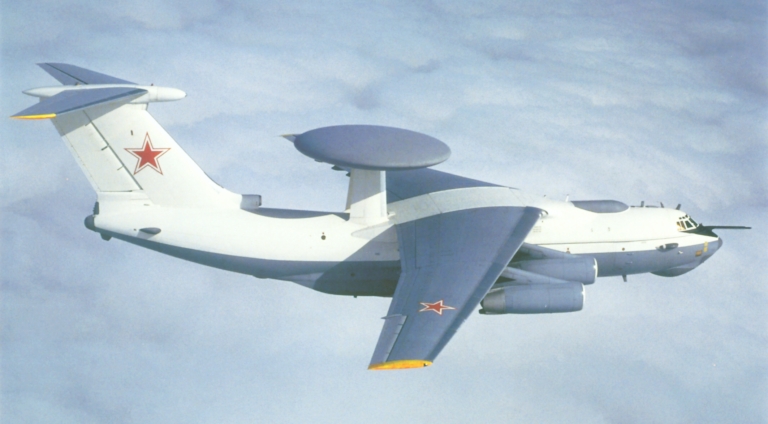
Beriev A-50 AWACS (Beriev).
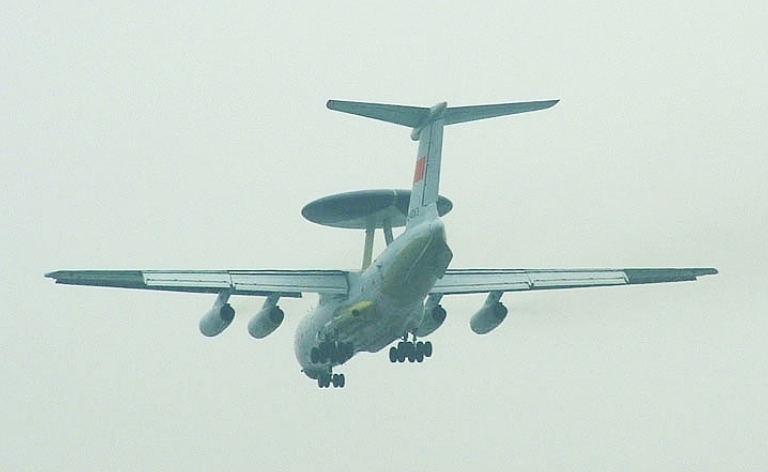 The PLA's new KJ-2000 AWACS prototype in the circuit at the Central Flight Test Establishment in Nanjing. Note the unique ventral strakes and APU exhaust in the port sponson (via Internet).
The PLA's new KJ-2000 AWACS prototype in the circuit at the Central Flight Test Establishment in Nanjing. Note the unique ventral strakes and APU exhaust in the port sponson (via Internet).
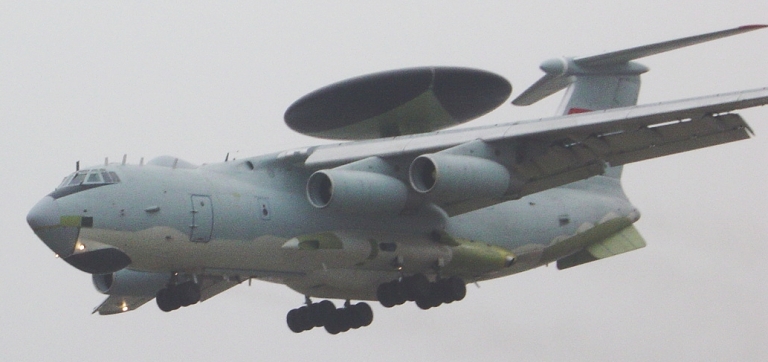
A respectable number of amatuer photographs of an A-50I aircraft being flown over Nanjing have since emerged on the Internet, some of remarkable quality. At least three prototypes were built, and flown in differing livery including a two tone grey camouflage. Chinese sources claim the aircraft is designated the KJ-2000.
Imagery clearly shows three sided phased array dielectric radomes, and wingtip ESM fairings, on a rebuilt Il-76 Candid airframe. An APU has been installed in the left main undercarriage fairing. Aft fuselage strakes, absent on the A-50, have been installed. The ram air inlet in the root of the vertical stabiliser of the A-50 is absent, as are the fuselage dielectric blister radomes for the ESM. The KJ-2000 prototypes have been photographed with and without aerial refuelling probes installed.
There has been some speculation that the PRC may be attempting to clone the Israeli Phalcon system using indigenous technology. Given that L-band radio frequency power transistors of suitable ratings are available commercially, cloning is feasible and entirely consistent with the long running PLA policy of concurrently developing indigenous products while importing foreign equivalents. An L-band array Transmit-Receive module design of suitable performance and configuration could be used for both the A-50 system and the smaller Y-8 design, sharing most of the system hardware and software. A least one image exists of a ground based antenna testing rig, built up as an AESA radome and mount on top of a mast on a larger building.
What remains unclear at this time is the IOC for an operational system, and specific performance parameters for the AESA, such as module count and peak power rating. It is reasonable to speculate that these parameters would be very similar to the Israeli Elta design, to which the PLA had considerable exposure. Media reports suggest that in late 2009 four PLA KJ-2000 systems were operational, but it is not known what the status of the onboard mission systems is.
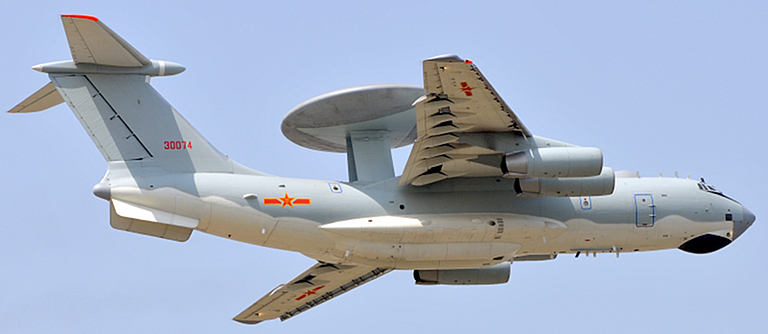
An early production KJ-2000 Airborne Early Warning and Control system T/N 30074 in flight. Note the prominant ventral stabilisers and wingtip ESM radomes (image © 2009, Zhenguan Studio).
The PLA has two other AEW&C development programs under way at this time, with multiple photographs now circulating on the Internet.
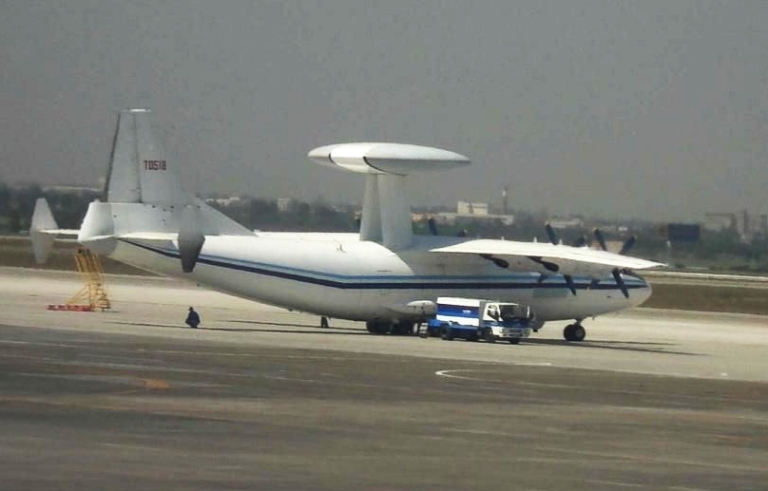
The Y-8 (An-12 Cub) AEW&C prototype using a conventional radar and rotodome. This design was recently exported to Pakistan, as the ZDK-03, on a new airframe (via Internet).
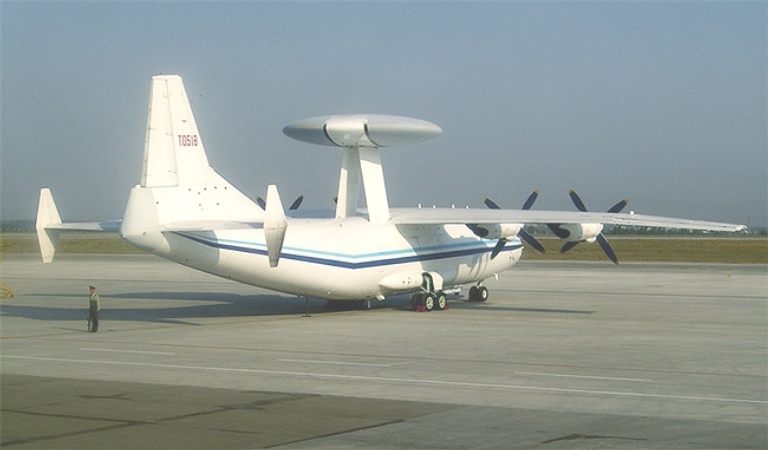
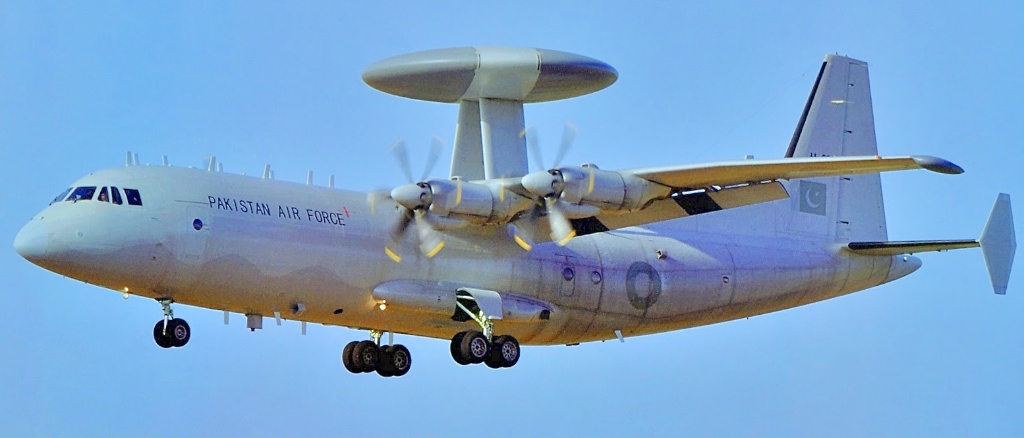
Production ZDK-03 AEW&C system, dubbed the Karakorum Eagle, one of four systems exported to Pakistan on the late production Shaanxi Y-8 airframe. The unusual camouflage is modelled on the USAF MC-2A proposal and is optimal for high altitude ISR aircraft (PAF).
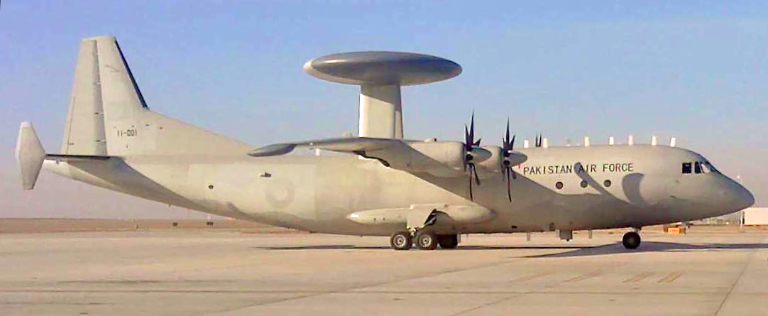
The first is a conventional radar using a rotodome, the installation mounted on a Shaanxi Y-8 (An-12 Cub) transport. The resulting AEW&C system is in the class of the C-130H and P-3B AEW&C systems built by Lockheed-Martin using the APS-145 UHF radar from the E-2C. As no images are available showing the exposed main antenna, it is impossible to draw conclusions about radar operating wavelength and antenna gain and sidelobe performance. The airframe is a 'classic' Y-8 Cub, with additional vertical stabilisers on the tips of the horizontal tails.
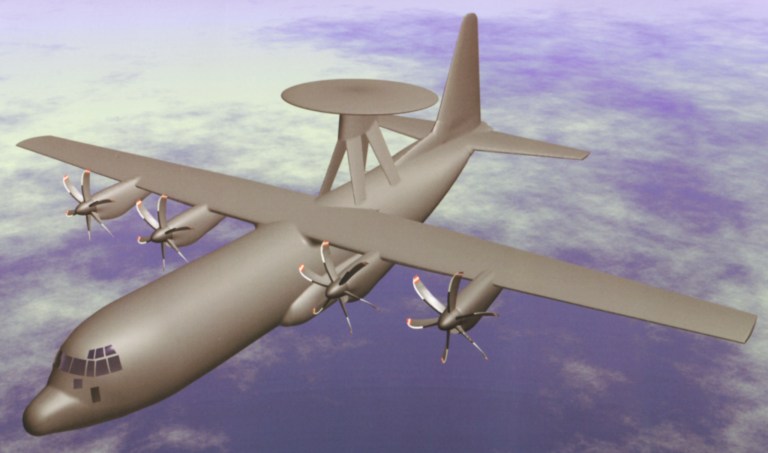
Lockheed-Martin C-130J AEW&C Proposal (LM).
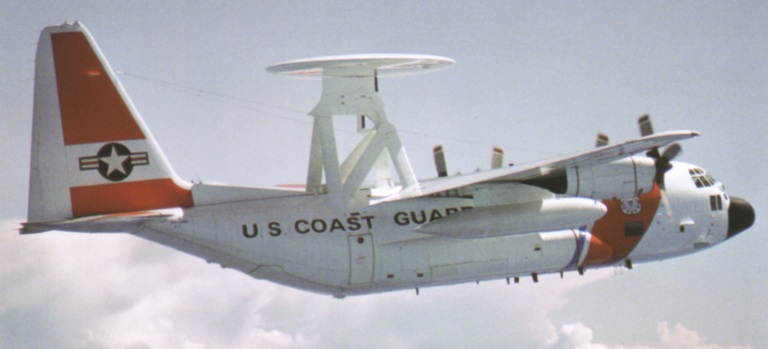
Operational USCG C-130H AEW&C System (USCG).

Never regarded to be particularly successful, the KJ-1 was China's first attempt to develop an AEW&C capability, during the 1960s. A surviving example is on display at Datangshan. The conventional rotodome on a rotational coupler employed back to back radar and IFF antennas, emulating the US Navy E-2B/C series ( © 2010, Air Power Australia; via Zhenguan Studio).

By the 1990s the PLA decided it had to have an AEW&C capability after observing the rout of the Iraqi air force in Desert Storm, and the Serbian air force in Allied Force. China sought to acquire the latest technology and contracted Israeli industry to rehost the Elta Phalcon L-band phased array radar, at the time also bid to the RAAF on an A-310 airframe, on a Russian Ilyushin Il-76 Candid airframe, emulating the Soviet Beriev A-50 Mainstay AEW&C design. The L-band Phalcon was the basis of the Elta bid for the RAAF Wedgetail program and is a generation ahead of Japan's E-767 AEW&C and Taiwan's E-2T Hawkeye.
US pressure on Israel killed the A-50I deal in July, 2000, upon which reports soon emerged that the Russian Beriev A-50U or A-50E variant, equipped with the Schmel series mechanically steered array, was to be purchased. India subsequently signed with Israel to pick up the A-50I instead of China.
The collapse of China's plan to acquire the Beriev A-50I AEW&C with the Israeli Elta Phalcon phased array radar was a significant setback for the PLA-AF, and loss of face globally to the US. The Chinese leadership vowed publicly they would get an AEW&C capability.
Unsupported claims of an impending buy of the Russian Beriev A-50U or A-50E continued, until photographs emerged on the Internet during the 2003 period showing what was clearly an A-50 like AEW&C being flown from the Central Flight Test Establishment at Nanjing.

Beriev A-50 AWACS (Beriev).


A respectable number of amatuer photographs of an A-50I aircraft being flown over Nanjing have since emerged on the Internet, some of remarkable quality. At least three prototypes were built, and flown in differing livery including a two tone grey camouflage. Chinese sources claim the aircraft is designated the KJ-2000.
Imagery clearly shows three sided phased array dielectric radomes, and wingtip ESM fairings, on a rebuilt Il-76 Candid airframe. An APU has been installed in the left main undercarriage fairing. Aft fuselage strakes, absent on the A-50, have been installed. The ram air inlet in the root of the vertical stabiliser of the A-50 is absent, as are the fuselage dielectric blister radomes for the ESM. The KJ-2000 prototypes have been photographed with and without aerial refuelling probes installed.
There has been some speculation that the PRC may be attempting to clone the Israeli Phalcon system using indigenous technology. Given that L-band radio frequency power transistors of suitable ratings are available commercially, cloning is feasible and entirely consistent with the long running PLA policy of concurrently developing indigenous products while importing foreign equivalents. An L-band array Transmit-Receive module design of suitable performance and configuration could be used for both the A-50 system and the smaller Y-8 design, sharing most of the system hardware and software. A least one image exists of a ground based antenna testing rig, built up as an AESA radome and mount on top of a mast on a larger building.
What remains unclear at this time is the IOC for an operational system, and specific performance parameters for the AESA, such as module count and peak power rating. It is reasonable to speculate that these parameters would be very similar to the Israeli Elta design, to which the PLA had considerable exposure. Media reports suggest that in late 2009 four PLA KJ-2000 systems were operational, but it is not known what the status of the onboard mission systems is.

An early production KJ-2000 Airborne Early Warning and Control system T/N 30074 in flight. Note the prominant ventral stabilisers and wingtip ESM radomes (image © 2009, Zhenguan Studio).
The PLA has two other AEW&C development programs under way at this time, with multiple photographs now circulating on the Internet.

The Y-8 (An-12 Cub) AEW&C prototype using a conventional radar and rotodome. This design was recently exported to Pakistan, as the ZDK-03, on a new airframe (via Internet).


Production ZDK-03 AEW&C system, dubbed the Karakorum Eagle, one of four systems exported to Pakistan on the late production Shaanxi Y-8 airframe. The unusual camouflage is modelled on the USAF MC-2A proposal and is optimal for high altitude ISR aircraft (PAF).

The first is a conventional radar using a rotodome, the installation mounted on a Shaanxi Y-8 (An-12 Cub) transport. The resulting AEW&C system is in the class of the C-130H and P-3B AEW&C systems built by Lockheed-Martin using the APS-145 UHF radar from the E-2C. As no images are available showing the exposed main antenna, it is impossible to draw conclusions about radar operating wavelength and antenna gain and sidelobe performance. The airframe is a 'classic' Y-8 Cub, with additional vertical stabilisers on the tips of the horizontal tails.

Lockheed-Martin C-130J AEW&C Proposal (LM).

Operational USCG C-130H AEW&C System (USCG).
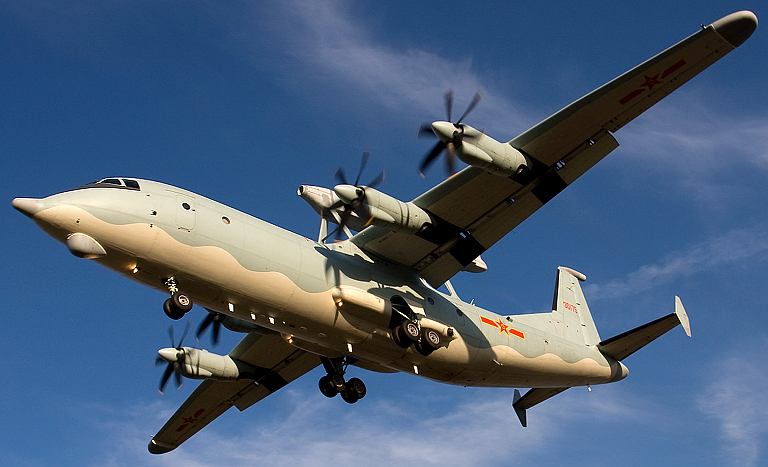
KJ-200 AEW&C system in flight (image © 2009, Zhenguan Studio).
The second smaller AEW&C program has been labelled the KJ-200 or 'Y-8 Balanced Beam' system. Installed on a late model Y-8F-600 airframe with Pratt & Whitney Canada PW150B turboprops and Honeywell avionics, the KJ-200 has been observed in the Nanjing area flying with a dorsal structure resembling the Ericsson Erieye AESA system, as well as ventral radomes. With a similar payload/volume to the C-130A, a Y-8 with an Erieye clone AEW&C system would be equivalent in performance and endurance to the C-130/Erieye proposals marketed during the late 1990s.
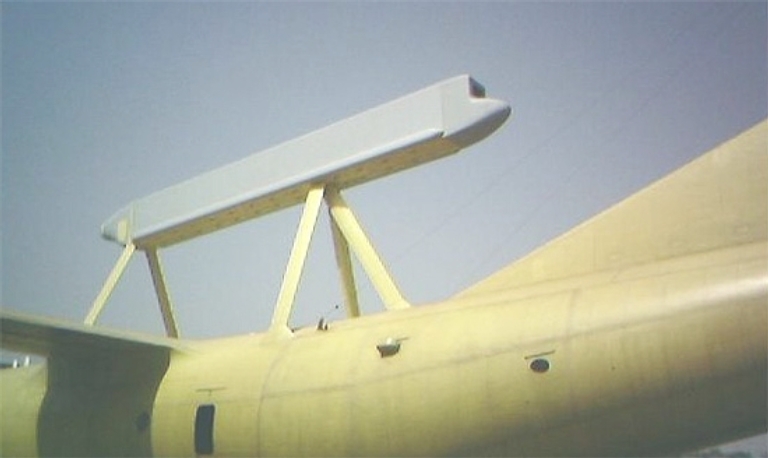
The KJ-200 or 'Y-8 Balanced Beam' AEW&C prototype (Via Internet).
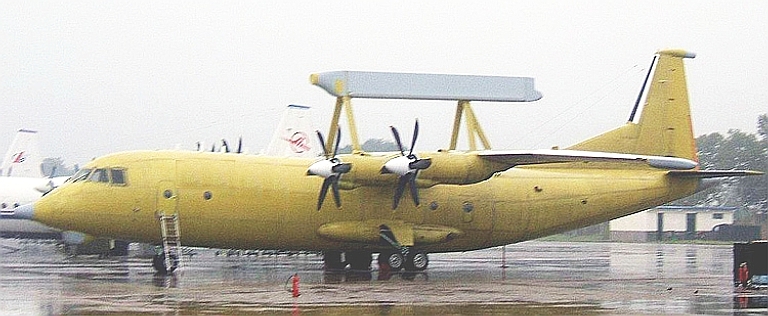
Imagery shows that the KJ-200 antenna assembly is much like the Swedish Ericsson PS-890, including the ram air cooling system for the transmit-receive modules. Like the Erieye, the KJ-200 cannot provide coverage over the nose, but due to large aperture size will have excellent broadside power-aperture ratings and angular resolution.
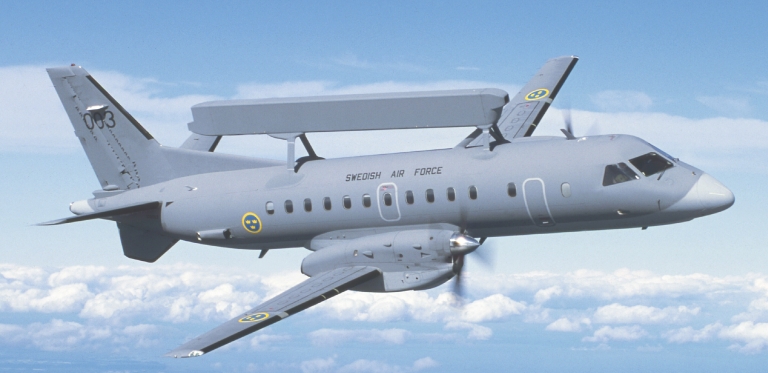
The SAAB/Ericksson Erieye installation (SAAB).
Given the similar size and platforms used for the two smaller AEW&C systems, it is a reasonable assessment that the rotodome system was developed as a risk hedge in the event that the KJ-200 AESA was too difficult to develop.
Press reports from Pakistan and India in 2007 indicated that China had signed a deal with Pakistan to supply an unspecified number of 'AEW&C aircraft'. Given reports that Pakistan was to acquire the SAAB/Ericsson Erieye system, it was not entirely clear what Pakistan intended, or which of the three Chinese systems was sought. India's acquisition of the A-50I would be a strong incentive for Pakistan to acquire the KJ-2000 to match capability. More recently, photographic imagery and PAF media releases showed the aircraft to be the CETC ZDK-03, which is a derivative of the original rotodome based system.
Chinese media releases suggested, in 2011, that the KJ-200 was being deployed with PLANAF air defence units.
It remains to be seen, longer term, which of the three PLA AEW&C systems will proliferate in the global export market. Regional clients who do not want the political strings attached to US or EU products, or the cost of a Russian or Israeli product, may well find a Chinese AEW&C offering attractive.
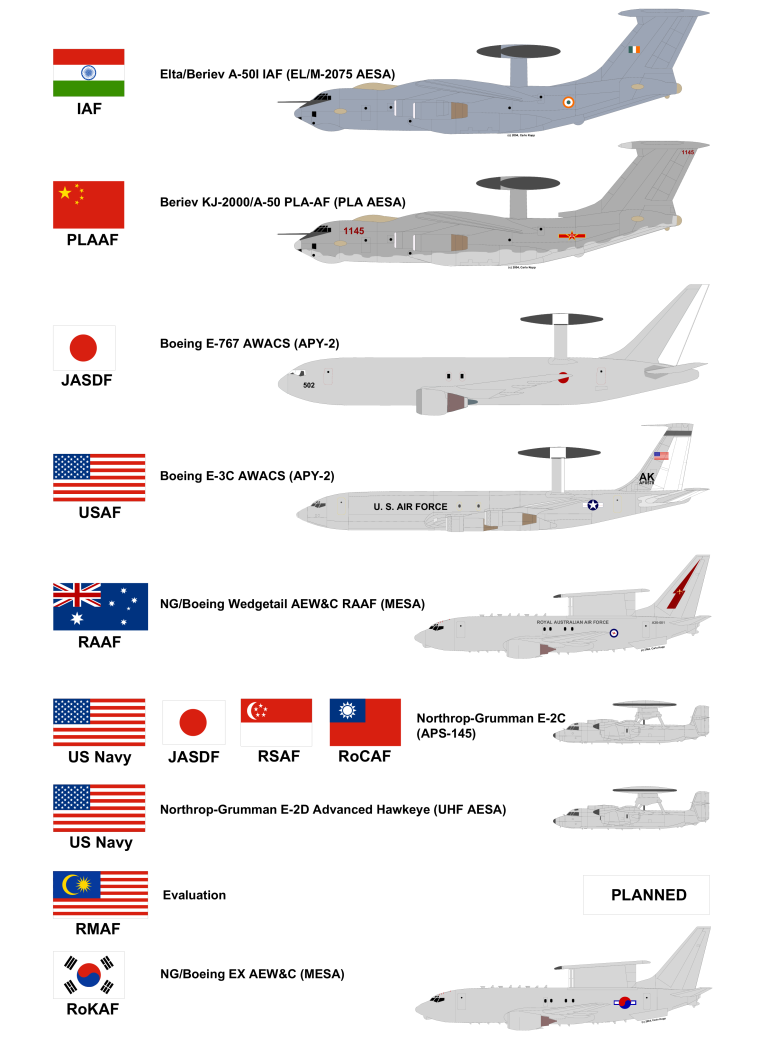
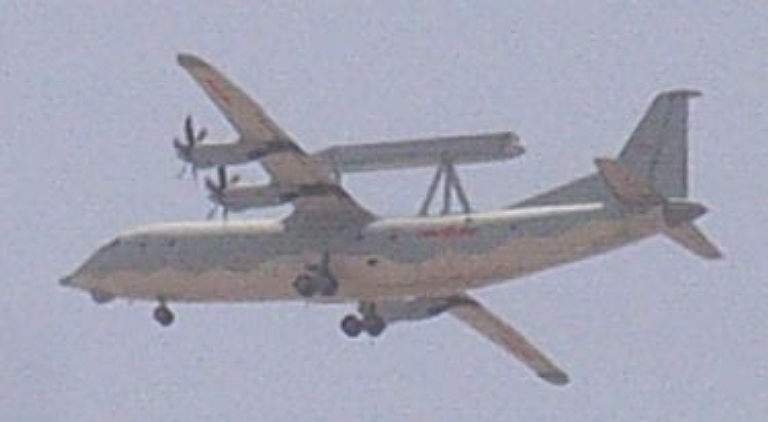
A camouflaged KJ-200 or 'Y-8 Balanced Beam' AEW&C prototype in flight (Via Internet).
KJ-2000 / A-50I Imagery
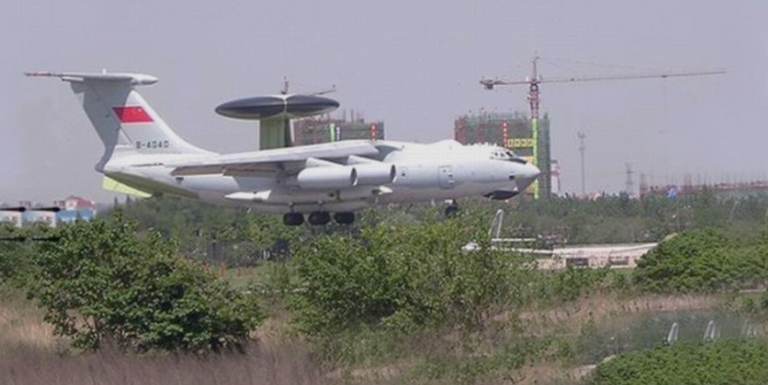
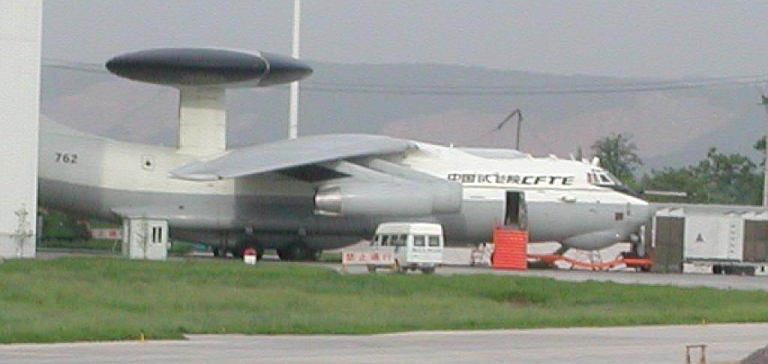
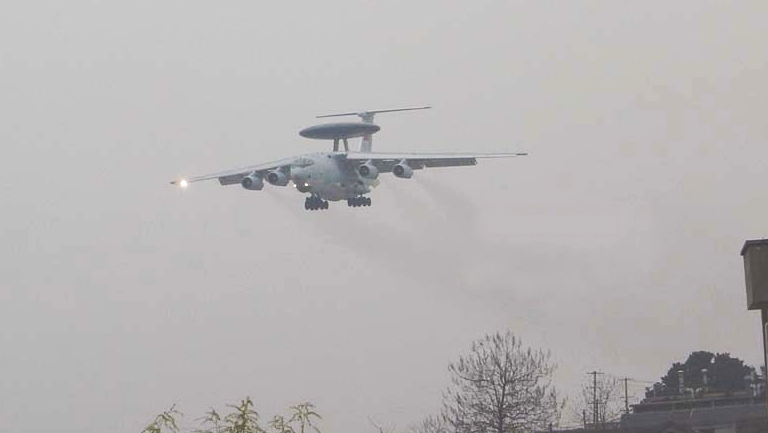
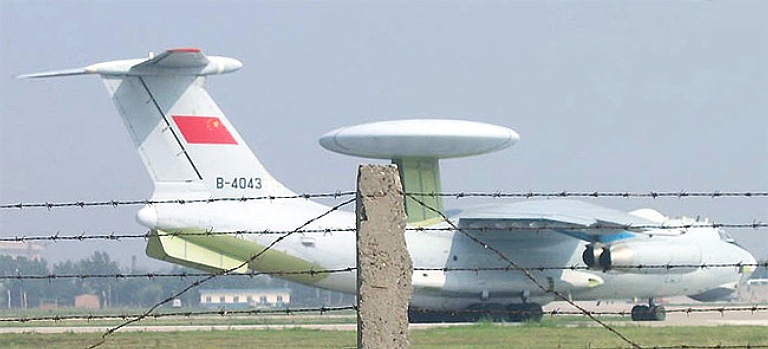
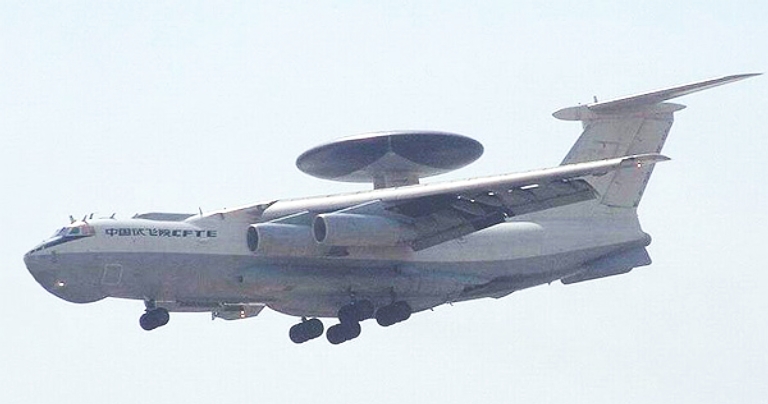
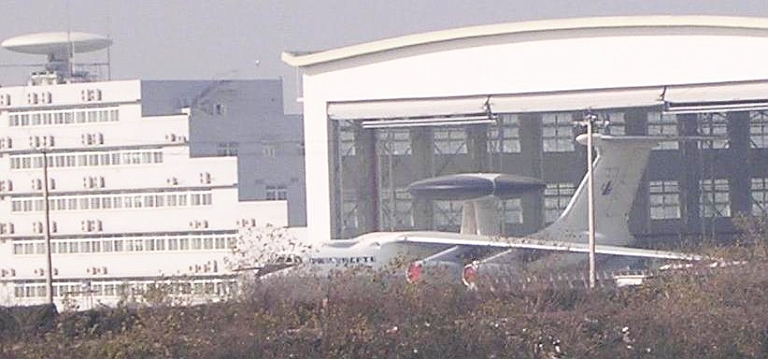
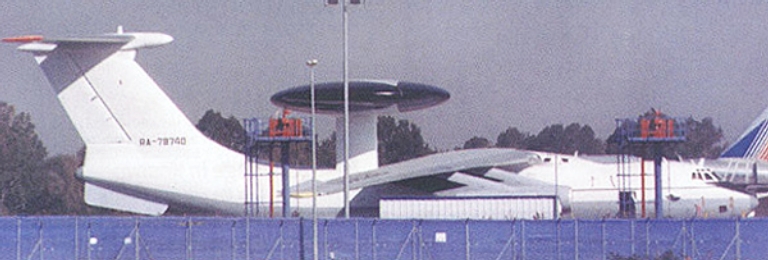
Partially completed A-50I Prototype (via Internet)
KJ-200 AEW&C Imagery
All images © 2010, Air Power Australia; via Zhenguan Studio
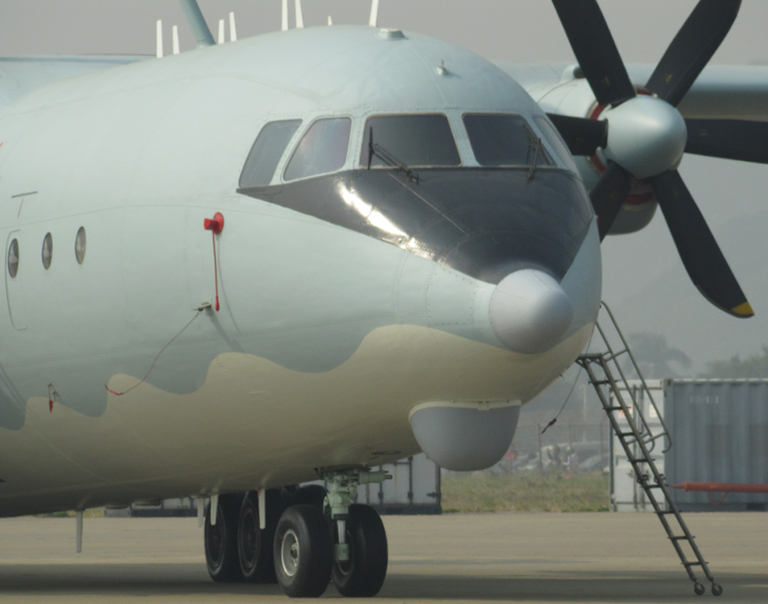
Detail of nose radomes on KJ-200.
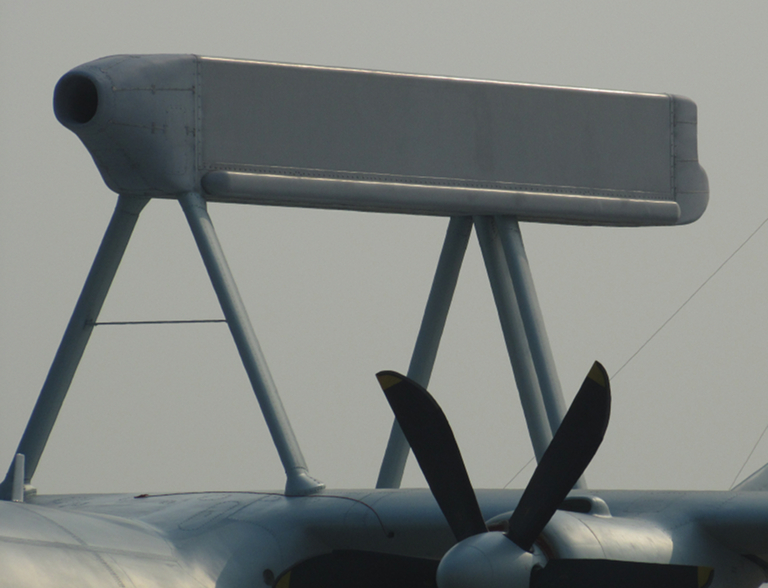
Above, below: Two details of S-band primary AESA arrangement.
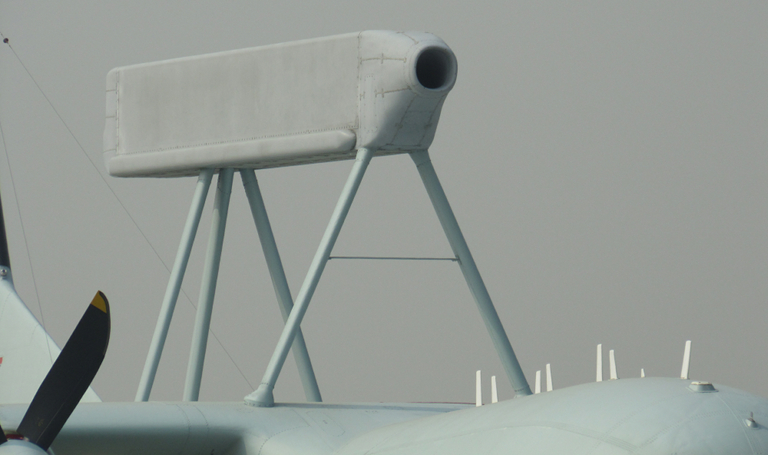
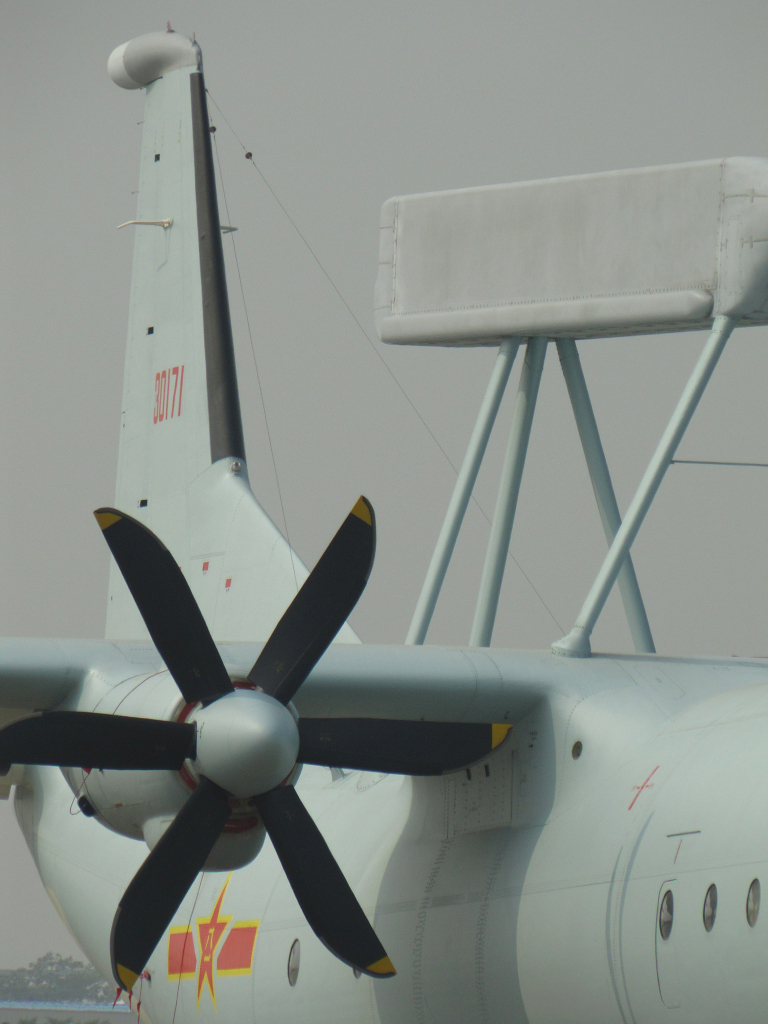
Detail of antenna mounting struts.
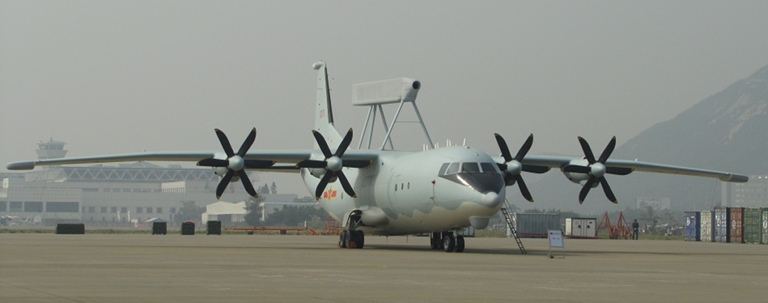
Above, below: general arrangement.
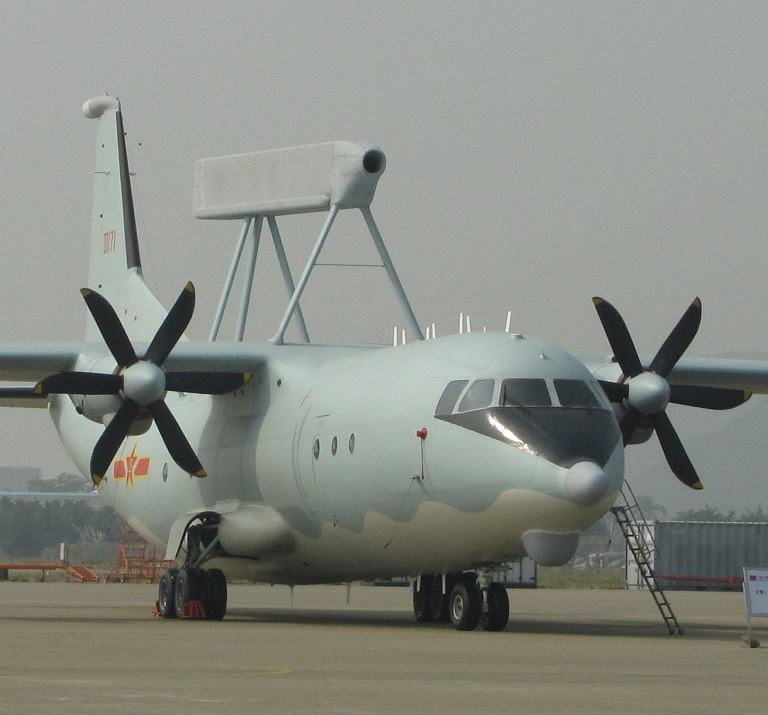
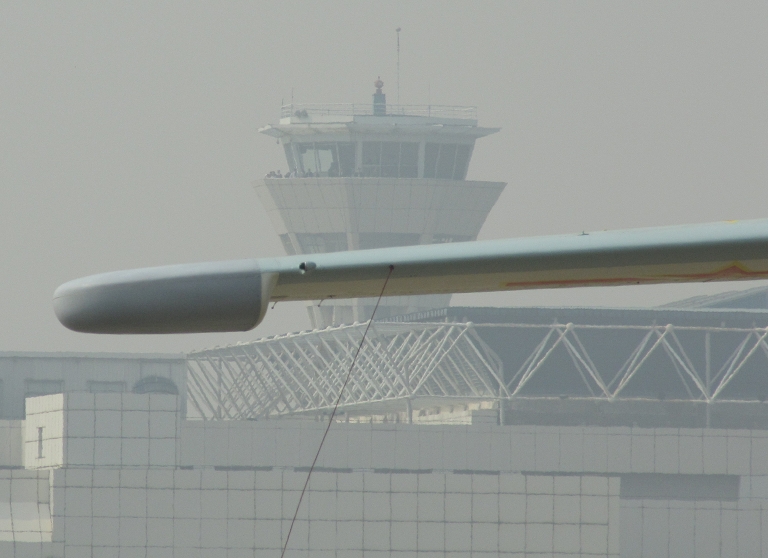
Wingtip ESM radome.
Sadly,no.
We just have 4 E-3F Sentry (under modrnization,it seems that there are some French modificiations on it,but don't know what..) and 3 Hawkeye (used by our navy).
Last edited:
Further GlobalEye sales already on radar, says Saab chief
Buskhe says the Swedish company’s GlobalEye flight test campaign is “going extremely well”.
“We are now flying with a fully integrated mission system and flying many hours, with good data," he says. “The capability of the system is mainly better than we believed.”

Saab
Saab has previously declined to detail when shipments of the Bombardier Global 6000-based GlobalEye will commence for launch customer the United Arab Emirates, which has three examples on order. However, during a first-quarter earnings call on 26 April, Buskhe commented that “this programme will start deliveries next year”.
Without disclosing potential additional sales prospects, Buskhe says the company is “in discussion with some customers of new orders that we hope could materialise in the years to come”. Saab is seeing "huge interest" in the product, he adds.
Equipped with a Saab Erieye ER active electronically scanned array radar, Leonardo Seaspray 7500E maritime search radar, an electro-optical/infrared sensor and electronic warfare equipment, the GlobalEye will be capable of performing simultaneous surveillance of airborne, land and naval targets.
Two of the heavily modified long-range business jets are currently involved in a flight-test campaign that was launched in March 2018.
Further GlobalEye sales already on radar, says Saab chief
- 01 MAY, 2019
- BY: CRAIG HOYLE
Buskhe says the Swedish company’s GlobalEye flight test campaign is “going extremely well”.
“We are now flying with a fully integrated mission system and flying many hours, with good data," he says. “The capability of the system is mainly better than we believed.”
Saab
Saab has previously declined to detail when shipments of the Bombardier Global 6000-based GlobalEye will commence for launch customer the United Arab Emirates, which has three examples on order. However, during a first-quarter earnings call on 26 April, Buskhe commented that “this programme will start deliveries next year”.
Without disclosing potential additional sales prospects, Buskhe says the company is “in discussion with some customers of new orders that we hope could materialise in the years to come”. Saab is seeing "huge interest" in the product, he adds.
Equipped with a Saab Erieye ER active electronically scanned array radar, Leonardo Seaspray 7500E maritime search radar, an electro-optical/infrared sensor and electronic warfare equipment, the GlobalEye will be capable of performing simultaneous surveillance of airborne, land and naval targets.
Two of the heavily modified long-range business jets are currently involved in a flight-test campaign that was launched in March 2018.
Further GlobalEye sales already on radar, says Saab chief
Everything you could ever want to know about flying the U-2 spy plane
We heard from two U-2 pilots about what it’s like to operate the storied aircraft.
By Rob Verger
May 9, 2019

A U-2 in the process of executing a touch-and-go maneuver at Al Dhafra Air Base in the United Arab Emirates in March.
Senior Airman Gracie Lee
Imagine the US aerial intelligence-gathering apparatus, and drones and satellites probably come to mind. But for decades, and still today, the military has also been using a spy plane called the U-2 to collect information about what’s below using instruments like radar, antennas, and even a film camera. Challenging to fly and especially hard to land, the aircraft cruises comfortably in the neighborhood of 70,000 feet off the ground.
We recently heard from two U-2 spy plane pilots about what it’s like to operate this aircraft and how the Air Force uses it today. Here’s what we learned.
The landing literally involves a speeding car
The U-2 loves heights—it has nearly twice the cruising altitude of a commercial jet. That’s thanks to its long, glider-like wings, which span 105 feet across. “This jet does not want to be on the ground, and that’s a real problem when it comes to landing,” says Matt Nauman, a U-2 pilot.
One complicating factor when landing is the dearth of wheels on the plane: to save weight, its designer gave it just two sets of wheels, lined up like bicycle tires, front to back, under the fuselage. Compare that with the landing gear on commercial planes like the 737, which has a stable triangle pattern: two sets of wheels next to each other under the wings, and one up front.
In other words, when a U-2 lands, there’s nothing to keep the wings from tipping and hitting the ground except the pilot’s skill. Because of the big wings, which provide oodles of lift, and the scant landing gear, the pilots need help when plopping it on the ground. “We’ll actually slow down, and the nose will continue to come up until the plane essentially falls out of the sky at two feet [off the ground], so we slow it down enough where it can no longer fly itself,” Nauman says.
To get an outside viewpoint, another U-2 pilot literally drives behind the aircraft at high speeds while it’s landing, radioing information to the pilot in the plane to help them land. Vehicles like Mustangs, Camaros, Pontiac G8s, and Chargers have done that job, says Travis Patterson, another U-2 pilot. “He’s actually talking the pilot down a little bit,” Patterson says, “just to help him out.”
The pilot wears a spacesuit and eats out of a tube
The cockpit of a U-2 is pressurized to around 15,000 feet of altitude, but the plane itself operates much higher off the ground. In case they need to eject or they face another problem, the pilots wear a spacesuit for the entire flight, like the one that Felix Baumgartner wore when jumping out of a balloon from 128,000 feet off the ground. That gear makes landing the plane more complex, too. “You’re effectively wearing a fishbowl on your head,” says Patterson, “and you’re trying to land one of the most difficult aircraft in the world.”
As for what they eat? “It’s actually a toothpaste tube full of food, like an MRE in a tube, that you eat through a port in your helmet,” Nauman says, although he says they’re working on improving that cuisine.
The point is to gather intelligence
The aircraft doesn’t carry kinetic weapons like guns. But Patterson says that it’s not helpless, as it does have a “self-defence system.”
So instead of kinetic weapons, it carries sensors like antennas, radar, and imaging equipment to gather intelligence and send it back down to the surface in real time. The plane is Mr.-Potato-Head-like, in that it’s modular: the Air Force can swap out what payloads and sensors they want it to carry.
“The missions are reconnaissance-based,” Patterson says. “If you think about the hot spots on the globe—right now we’re focusing on big players like China, and Russia, Iran, North Korea—there’s probably a U-2 flying somewhere in those areas right now, taking a look at what’s going on.”
The plane flies in international airspace, as opposed to directly over a country that’s a surveillance target. The idea is that the sensors can see so far—for example, a large radar unit in the nose is capable of peering some 300 miles in one direction from an altitude of 70,000, Patterson says—meaning that being “parked off someone’s coast” still enables a nice view inland.
The plane also can carry a digital-camera-like imager with a “lens about the size of a pizza platter,” says Patterson, that can image in different parts of the light spectrum that aren't visible to the human eye or consumer-grade cameras.
And yes, it still shoots on film sometimes. It features a “giant wet film camera,” Patterson says, that carries about 10,500 feet of film. That film produces high-fidelity pictures of what’s below. Plus, Nauman says that shooting on film allows them to share imagery more easily with allies without running into issues pertaining to alterability or whether or not something is classified. “That film camera actually just lets us develop that film and distribute it as need be,” Nauman says.
Finally, it’s easy to imagine that the pilots would land the plane and then hand over a couple hard drives to intelligence analysts. But instead, the craft shares its data (just not what comes out of the film camera) with the surface while the plane is still in the air.
They take the information they gather, “and we pipe it over a data link to a satellite, and then down to the ground somewhere else in the world where we have a team of almost 300 intel analysts sitting there, operating as our crew,” Patterson says. They can also send the data straight to the ground, skipping that satellite link.

A U-2 on a runway at Al Dhafra Air Base, United Arab Emirates, in March.
Senior Airman Gracie Lee
It’s been flying a long time
The first U-2 flew in 1955, although most of the planes with the U-2 name in service today were built in the mid-1980s, Patterson says. The fleet numbers around 30 planes, plus four craft that have two seats in them used to train pilots. The airframes may still be flying through 2040 or even 2050, Patterson says, because once the plane gets up high, the stress on the craft is low.
“We’re not a fighter, where we’re pulling a lot of g-force,” Patterson says. “Once it gets to altitude, it’s smooth, and quiet—and it’s very, very nice on the airplane. The only tough part is the landing.”

 www.popsci.com
www.popsci.com
We heard from two U-2 pilots about what it’s like to operate the storied aircraft.
By Rob Verger
May 9, 2019
A U-2 in the process of executing a touch-and-go maneuver at Al Dhafra Air Base in the United Arab Emirates in March.
Senior Airman Gracie Lee
Imagine the US aerial intelligence-gathering apparatus, and drones and satellites probably come to mind. But for decades, and still today, the military has also been using a spy plane called the U-2 to collect information about what’s below using instruments like radar, antennas, and even a film camera. Challenging to fly and especially hard to land, the aircraft cruises comfortably in the neighborhood of 70,000 feet off the ground.
We recently heard from two U-2 spy plane pilots about what it’s like to operate this aircraft and how the Air Force uses it today. Here’s what we learned.
The landing literally involves a speeding car
The U-2 loves heights—it has nearly twice the cruising altitude of a commercial jet. That’s thanks to its long, glider-like wings, which span 105 feet across. “This jet does not want to be on the ground, and that’s a real problem when it comes to landing,” says Matt Nauman, a U-2 pilot.
One complicating factor when landing is the dearth of wheels on the plane: to save weight, its designer gave it just two sets of wheels, lined up like bicycle tires, front to back, under the fuselage. Compare that with the landing gear on commercial planes like the 737, which has a stable triangle pattern: two sets of wheels next to each other under the wings, and one up front.
In other words, when a U-2 lands, there’s nothing to keep the wings from tipping and hitting the ground except the pilot’s skill. Because of the big wings, which provide oodles of lift, and the scant landing gear, the pilots need help when plopping it on the ground. “We’ll actually slow down, and the nose will continue to come up until the plane essentially falls out of the sky at two feet [off the ground], so we slow it down enough where it can no longer fly itself,” Nauman says.
To get an outside viewpoint, another U-2 pilot literally drives behind the aircraft at high speeds while it’s landing, radioing information to the pilot in the plane to help them land. Vehicles like Mustangs, Camaros, Pontiac G8s, and Chargers have done that job, says Travis Patterson, another U-2 pilot. “He’s actually talking the pilot down a little bit,” Patterson says, “just to help him out.”
The pilot wears a spacesuit and eats out of a tube
The cockpit of a U-2 is pressurized to around 15,000 feet of altitude, but the plane itself operates much higher off the ground. In case they need to eject or they face another problem, the pilots wear a spacesuit for the entire flight, like the one that Felix Baumgartner wore when jumping out of a balloon from 128,000 feet off the ground. That gear makes landing the plane more complex, too. “You’re effectively wearing a fishbowl on your head,” says Patterson, “and you’re trying to land one of the most difficult aircraft in the world.”
As for what they eat? “It’s actually a toothpaste tube full of food, like an MRE in a tube, that you eat through a port in your helmet,” Nauman says, although he says they’re working on improving that cuisine.
The point is to gather intelligence
The aircraft doesn’t carry kinetic weapons like guns. But Patterson says that it’s not helpless, as it does have a “self-defence system.”
So instead of kinetic weapons, it carries sensors like antennas, radar, and imaging equipment to gather intelligence and send it back down to the surface in real time. The plane is Mr.-Potato-Head-like, in that it’s modular: the Air Force can swap out what payloads and sensors they want it to carry.
“The missions are reconnaissance-based,” Patterson says. “If you think about the hot spots on the globe—right now we’re focusing on big players like China, and Russia, Iran, North Korea—there’s probably a U-2 flying somewhere in those areas right now, taking a look at what’s going on.”
The plane flies in international airspace, as opposed to directly over a country that’s a surveillance target. The idea is that the sensors can see so far—for example, a large radar unit in the nose is capable of peering some 300 miles in one direction from an altitude of 70,000, Patterson says—meaning that being “parked off someone’s coast” still enables a nice view inland.
The plane also can carry a digital-camera-like imager with a “lens about the size of a pizza platter,” says Patterson, that can image in different parts of the light spectrum that aren't visible to the human eye or consumer-grade cameras.
And yes, it still shoots on film sometimes. It features a “giant wet film camera,” Patterson says, that carries about 10,500 feet of film. That film produces high-fidelity pictures of what’s below. Plus, Nauman says that shooting on film allows them to share imagery more easily with allies without running into issues pertaining to alterability or whether or not something is classified. “That film camera actually just lets us develop that film and distribute it as need be,” Nauman says.
Finally, it’s easy to imagine that the pilots would land the plane and then hand over a couple hard drives to intelligence analysts. But instead, the craft shares its data (just not what comes out of the film camera) with the surface while the plane is still in the air.
They take the information they gather, “and we pipe it over a data link to a satellite, and then down to the ground somewhere else in the world where we have a team of almost 300 intel analysts sitting there, operating as our crew,” Patterson says. They can also send the data straight to the ground, skipping that satellite link.
A U-2 on a runway at Al Dhafra Air Base, United Arab Emirates, in March.
Senior Airman Gracie Lee
It’s been flying a long time
The first U-2 flew in 1955, although most of the planes with the U-2 name in service today were built in the mid-1980s, Patterson says. The fleet numbers around 30 planes, plus four craft that have two seats in them used to train pilots. The airframes may still be flying through 2040 or even 2050, Patterson says, because once the plane gets up high, the stress on the craft is low.
“We’re not a fighter, where we’re pulling a lot of g-force,” Patterson says. “Once it gets to altitude, it’s smooth, and quiet—and it’s very, very nice on the airplane. The only tough part is the landing.”

Everything you could ever want to know about flying the U-2 spy plane
This is what it's like to fly (and land) an Air Force U-2.
Boeing E-3 Sentry

- Origin
- USA
- Type
- airborne early-warning and control aircraft
- Max
- Speed
- 853 km/h / 530 mph
- Max
- Range
- endurance on station 1609 km (1,000 miles) from base 6 hours; maximum unrefuelled endurance exceeds 11 hours
- Dimensions
- span 44.42 m (145 ft 9 in)
- length 46.61 m (152 ft 11 in)
- height 12.73 m (41 ft 9 in)
- Weight
- maximum take-off 147,418 kg / 325,000 Ib
- Powerplant
- four 9525-kg (21,000Ib) thrust Pratt & Whitney TF33-PW-100A turbofan engines; (Saudi 9979-kg/22,000-lb CFM56-2-A2 turbofans)
- Armament
- none
- Operators:
- France (E-3F), Saudi Arabia (E-3A), United Kingdom (E-3D), United States (E-3B/C)
AWACS: A MODIFIED 707 WITH A COMPUTER THAT CAN TRACK 400 PLANES
Special to the New York Times
APRIL 22, 1981
The Awacs electronic surveillance planes that the Reagan Administration has decided to sell to Saudi Arabia are modified Boeing 707's that can fly for 72 hours with refueling.
Officially called the Airborne Warning and Control Systems, the planes also go by the designation E-3C Sentry.
They are designed primarily to provide warning of air attack and to command from the air tactical fighters to repel an attack. They can also be used to gather intelligence.
Each plane costs $131 million. The total bill to Saudi Arabia for five Awacs and spare parts, training aids, maintenance facilities and the communications apparatus that goes with the planes is expected to be $2 billion.
The plane requires a flight crew of 4 and 13 personnel to operate the sophisticated equipment on board. The plane cruises at 530 miles an hour at 30,000 feet.
Each plane has an I.B.M. computer that can track 400 aircraft simultaneously. There are nine consoles on board that can display all or part of a battlefield below.
The planes have Westinghouse pulse-Doppler radar systems with a range of 350 miles (563km) at high altitude and 250 miles (402 km) at low altitude. The radar system can remove clutter from the screen to distinguish vehicles on the ground or ships at sea.
Workstation prior to Upgrade
Since ther induction, approx US$2.5bn ~ US$3bn, has been spent in keeping the fleet updated


